Out of the BOX
By Lynne Margolis
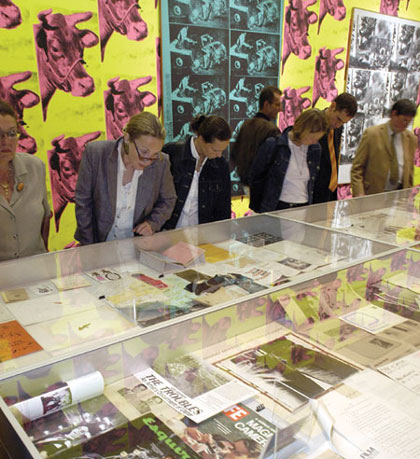
Visitors enjoyed a look
at the contents of 15 of Warhol’s Time Capsules when the exhibition first appeared at the Museum
für Moderne Kunst in Frankfurt, Germany.
Andy Warhol’s packrat tendencies have been
well-documented, as visitors to The Andy Warhol Museum’s
2002 Possession Obsession exhibition will recall. But
it takes a look inside his collection of cardboard-box
Time Capsules to get a true sense
of Warhol’s
apparently uncontrollable urge to save stuff. 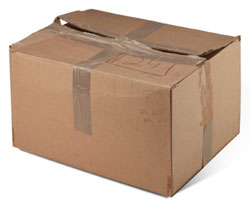 Like a
squirrel storing away acorns, he stashed endless
bits of ephemera—as well as items of great import—in
box after box. When each one was filled, it was sealed,
dated, and stored, and replaced by another empty
box so the process could start again. He started the
practice
in 1973, though the cartons harbor objects that date
back long before then. Like a
squirrel storing away acorns, he stashed endless
bits of ephemera—as well as items of great import—in
box after box. When each one was filled, it was sealed,
dated, and stored, and replaced by another empty
box so the process could start again. He started the
practice
in 1973, though the cartons harbor objects that date
back long before then.
Warhol left behind 612 of these
archaeological diaries, and The Warhol’s archivists
have managed to burrow through and catalog just over
100 of them. On October
3, the contents of about 15 of those boxes—some
3,000 items—will go on display in an exhibition
simply titled, Andy Warhol’s
Time Capsules.
Unlike
the not-really-random flea market finds that
crowded his New York brownstone to nearly
bursting,
Warhol didn’t seem to care what landed
in those boxes. He saved it all, regardless of
its
perceived
relevance. Assistant Museum Archivist Matt Wrbican
has unearthed everything from movie ticket stubs
and unpaid bills to pizza dough and a pair of
Clark Gable’s
shoes, not to mention many pieces of Warhol’s
earlier art. Finds include sketches of shoes
and a mummified foot; party invitations and a
piece
of Caroline
Kennedy’s birthday cake; unpaid bills and
receipts from important art buys.
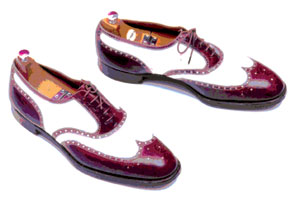 Whether he knew
that some day these boxes would hold invaluable
keys to his life and times is
debatable. Archivists believe Warhol eventually
decided that
would be the case—at least, he regarded
them as semi-illuminating pieces of pop art made
valuable because of who created
them. But they also agree that his original motivation
was more mundane: A child of the Depression,
he simply couldn’t throw anything out.
So the boxes became his garbage cans, where he
could reflect the debris
of pop culture back on itself and erase the lines
between what constituted art and what fell into
the realm of
that “disposable” culture at the
same time. Whether he knew
that some day these boxes would hold invaluable
keys to his life and times is
debatable. Archivists believe Warhol eventually
decided that
would be the case—at least, he regarded
them as semi-illuminating pieces of pop art made
valuable because of who created
them. But they also agree that his original motivation
was more mundane: A child of the Depression,
he simply couldn’t throw anything out.
So the boxes became his garbage cans, where he
could reflect the debris
of pop culture back on itself and erase the lines
between what constituted art and what fell into
the realm of
that “disposable” culture at the
same time.
“Over time, Warhol had to be aware that he was
creating something that was going to be of
tremendous interest
at some point in the future,” says John
Smith, The Warhol’s assistant director
for collections and research. “Warhol
was an incredibly savvy artist and businessman.”
Wrbican
says evidence of that attitude can be found
in items such as the 10 eight-track
tapes
he put
into one box. “Warhol probably picked
them up at a flea market,” Wrbican says, “thinking
they were artifacts that document our culture.” Support
for that theory lies in the fact that they
were found in a 1985 box, and eight-tracks
had become dinosaurs
long before that.
Warhol actually considered
selling some Time Capsules, but hadn’t
quite figured out how to market them. According
to the exhibition companion book, Andy Warhol’s
Time Capsule 21, he had resolved to increase
their sale price from his original $100 to
$4,000 or $5,000—that
is, if he ever got around to deciding he could
part with them.
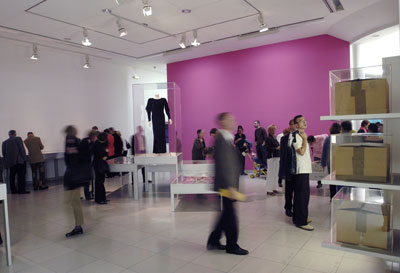
It’s About Time
It’s no accident that The Andy Warhol Museum
is showcasing these Time Capsules now. It is, after
all, the 10th anniversary of its opening, and capsules
are routinely opened by their custodians on such special
occasions. But the contents of these 15 boxes were
first displayed late last year at the Museum fur Moderne
Kunst in Frankfurt, Germany.
ArtForum Contributing
Editor Daniel Birnbaum listed Frankfurt’s presentation
of Andy Warhol’s
Time Capsules as one of his favorite exhibitions of
2003, stating, “I couldn’t stop pouring
over all the letters and postcards and stuff Warhol
collected. For an artist who likened his mind to a
tape recorder equipped only with an erase button, this
is a strangely Proustian project.”
“The scale of this show is so immense,” Smith
explains. “Each box has 200 to 300 single
objects in it. Multiply that by 15 and you realize
how many
different single pieces you’re talking about.
It would have been difficult for us to take on
a project like that on our own. By collaborating
on this exhibition
with the Museum fur Moderne Kunst in Germany, we
were able to do things we might not have been able
to do
with our limited resources.”
And these are
just a fraction of the first 100 Time Capsules.
The Warhol could hold a similar
exhibition
each year for the next 10 years and still cover
only another 150 boxes. Wrbican says opening
and cataloging
each new box is a mind-boggling experience. Every
item has to be examined, and if its nature is
not immediately
evident, archivists must try to decipher what
that item is—and what it could represent. What
might look like a seemingly innocuous receipt
could speak
volumes about Warhol’s world, and perhaps
even solve lingering mysteries.
For instance,
there’s the May 8, 1961, sales
statement from the Leo Castelli Gallery for
a Jasper Johns drawing Warhol purchased three
years
before he
began exhibiting his own work there. Warhol
and Castelli went into the gallery’s
back room to see what else was available, and
Warhol spotted
Roy Lichtenstein’s
then-controversial comic strip paintings. Warhol
mentioned he was creating similar work. A man
at the gallery,
Ivan Karp, expressed interest and was invited
to Warhol’s
studio, where he viewed Warhol’s depictions
of Nancy, Superman, Popeye, and other famous
cartoon characters.
The reason the statement
is important, Wrbican explains, is because
it set the previously
nebulous time frame
for Warhol’s interaction with Castelli,
Karp, and others who became important figures
in his life.
It also established a connection between that
event and the point at which his art was undergoing
major
changes, metamorphosing from an emphasis on
cutesy angels, kittens, and butterflies to
more daring—and
less readily accepted—subjects.
“He
knew that he wouldn’t become as well-known,
as famous, and, frankly, as wealthy if he continued
doing the same work that he was doing,” Wrbican
says. So Warhol again transformed himself,
as he had earlier when he changed his name
and left Pittsburgh.
In another Time Capsule,
archivists located
a statement from December 1961 indicating
Warhol still owed
money on the $350 purchase.
 Ironies and Oddities Ironies and Oddities
A Capsule full of circa-1956 items held a
rejection notice by the Museum of Modern Art in New
York City
for Warhol’s attempted gift of a shoe drawing.
It makes one wonder what kind of shoe they used to
kick themselves with later on.
In fact, it was Warhol’s
shoe fetish that led to his acquisition of Clark
Gable’s handmade
spectator shoes, a gift from the actor’s widow.
She saw a gossip column item—which Warhol apparently
planted—mentioning he was collecting celebrities’ shoes.
So she packed off a pair of her late husband’s
two-tones.
Other finds have less logical explanations—or
none at all. Even the archivists’ detective work
can’t always produce one, so they’re forced
to speculate why, for example, one box housed crumbling
bits of pizza dough.
Says Wrbican: “I don’t
know if this thing with the pizza dough is actually
a work of art, or
if Warhol may have just been trying to somehow document
in a really literal way, rather than with photographs—the
process of making pizza dough.”
Some of it looked
like a ball, and some pieces appeared to be flat,
which led Wrbican to theorize that Warhol
may have been attempting to show the actual steps
of working the dough. It’s possible he was
feeling the influence of several fellow artists who
were then
working with food as their medium. There’s
also the unstated possibility that it was another
of Warhol’s
little gags, the joke being that it meant nothing
significant at all.
The insect-infested dough has
long since been disposed
of, and Wrbican wishes he could figure out how
to create an exhibition version in a safer medium.
That
probably
won’t happen, but he and the exhibition’s
German designers came up with some clever ways to
display other artifacts, such as the elegant silver,
coffee
cup, menu cards, and other items the souvenir-loving
artist lifted during a flight on the transatlantic
Concorde found in Time Capsule 214. In a play on
the plane itself, the case holding these pieces is
built
on an incline, with tall legs on one end and short
ones on the other.
“I installed the objects at almost precisely
the exact same angle so they all looked like they were
sort of
taking off, flying out of the room,” Wrbican
explains. “People really loved that at
the exhibition in Germany.”
Contents and
Context
The sleek, brushed aluminum cases designed
for the German exhibition will be used here
in Pittsburgh
to display most of the same contents they originally
held.
The primary difference between the exhibitions,
according
to Wrbican, is the context in which the Time Capsules’ contents
will be seen. In Frankfurt, they were integrated
with that museum’s multi-artist modern
art collection, which put them in a broader
historical perspective.
Sometimes they were grouped with themes. For
example, Gable’s shoes, an autographed
Shirley Temple picture Warhol obtained as a
youth, and a silk panne
dress believed to have been worn by Jean Harlow
all were given a Hollywood label. The other
contents of
the boxes from which they came had little to
do with Tinseltown, but Wrbican says the designation “gives
the public something to grab onto.”
In
Pittsburgh, the displays will be surrounded
by Warhol’s
own work and will offer deeper insights into
his personal life and the chronology of his
career. The boxes were
carefully selected to convey both the momentous
and mundane.
One of Wrbican’s favorites
is Time Capsule 67, which had a particularly
rich yield of artifacts. In
addition to the Harlow dress and a Christmas
card from Paul McCartney, it contained five
maids’ costumes
from Milan. No one has figured out why Warhol
acquired them, though Wrbican surmises they
were created by
some well-known designer, perhaps Versace.
Wrbican was particularly amused by one item
in the box: Yves St. Laurent’s Christmas
gift to Warhol of an oversized Campbell’s
soup can containing a candle and embellished
with Laurent’s autograph.
Also good for a laugh is the High Times magazine
cover of Warhol and pal Truman Capote posing
with a dachshund.
Warhol is dressed as Santa; Capote appears
as Mao.
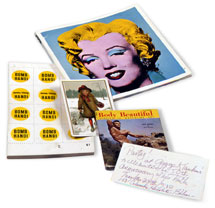 The Pittsburgh exhibition may include
a box or two more than the Frankfurt show because
Wrbican
wants
to work in more ‘80s artifacts. And he’s
still trying to figure out how to re-create
a highlight of the German exhibition: a series
of items belonging
to Warhol’s mother, Julia Warhola, presented
as an actual room with a closet, a bed, and
an end table. The closet held her clothes,
the table was loaded
with greeting cards from her grandchildren,
and the bed featured a “quilt” patterned
from 20 or so praying-hands Christmas cards
Warhol had designed,
interspersed with pieces showcasing Julia’s
fanciful writing. In Germany, the room appeared
in the museum
entrance because it represented Andy’s
own beginning. Because it won’t fit in
The Warhol’s entryway,
it probably will wind up on the fourth floor. The Pittsburgh exhibition may include
a box or two more than the Frankfurt show because
Wrbican
wants
to work in more ‘80s artifacts. And he’s
still trying to figure out how to re-create
a highlight of the German exhibition: a series
of items belonging
to Warhol’s mother, Julia Warhola, presented
as an actual room with a closet, a bed, and
an end table. The closet held her clothes,
the table was loaded
with greeting cards from her grandchildren,
and the bed featured a “quilt” patterned
from 20 or so praying-hands Christmas cards
Warhol had designed,
interspersed with pieces showcasing Julia’s
fanciful writing. In Germany, the room appeared
in the museum
entrance because it represented Andy’s
own beginning. Because it won’t fit in
The Warhol’s entryway,
it probably will wind up on the fourth floor.
Though the exhibition seemingly is all about
time, it was never intended to be linear—any
more so, that is, than the crazy-quilt thought
process of the
Time Capsules’ fascinatingly
eccentric creator.
Following its close in Pittsburgh, Andy Warhol’s
Time Capsules wil travel to the Natinal Gallery in
Melbourne, Australia, where it will be on view March
15 through May 8, 2005.
Andy
Warhol’s Time Capsule 21
The exhibition, Andy Warhol’s
Time Capsules,
is accompanied by the catalogue, Andy Warhol’s
Time Capsule 21, designed locally by Kendra Power
Design and Communication, Inc., and published by
Dumont. The book provides an illustrated, in-depth
look at the individual objects and ephemera found
in Time Capsule 21. With its photobooth strips of
Warhol Superstars, six self-portraits, revealing
business records, and plentitude of artwork from
the 1950s and 60s, Time Capsule 21 stands out as
one of the richest resources of Warhol’s oeuvre.
Also included in the book are essays by The Warhol’s
Director, Thomas Sokolowski, and the curatorial staff
at both the Museum für Moderne Kunst,
Back to Contents |